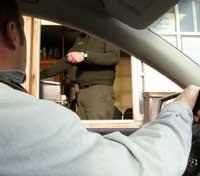A machine that knows your face
2011/03/19 Lakar Iraizoz, Oihane - Elhuyar Zientzia

Human beings have about 100 billion neurons in the brain. Intertwined form a wide network. Thanks to the work of neurons we can assimilate and understand what we perceive around us and from this information we accumulate knowledge. In fact, all the things we learn are trapped in the neuronal network.
Ibermatica has developed in Zamudio a system that mimics the way our brain acts to develop different applications. The system has artificial neural networks that basically organize the world that teach the system, "as we organize to differentiate farolas, animals and trees that we see in the mountain or in the street," explains Aitor Moreno.
Ibermatica is developing this system for specific applications. In one of the uses, the system is intended to be placed at the entrance of buildings to allow the exclusive access of registered persons. The system must know the faces of the authorized persons, opening automatically the barrier to the known persons.

The core of the system, teaching
How can a machine be able to see a face and know it quickly? The first step is to teach the system who people are to process the information of each of them. "Through several photos of the person we want to register," explains Maitane Garmendia, of Ibermatica.
When passing the photos to the computer, the system converts the colors in gray, that is, it changes to black and white. Then enter each photo in a matrix of 64 x 64 squares in which the information of each photo is stored. Somehow it converts photography into a large square of 64 x 64 squares.
They include several photos of each person in the system and repeat the process with each of them. "We managed to form the system," says Garmendia. The photographs have been taken in different positions so that the system internalizes the main characteristics of this person. "This is possible thanks to the structuring of the network on which it is based," explains Moreno.
As you introduce the photos, you are learning the system. He also makes mistakes. With what he has learned, when he receives an image, he classifies it and if he does not succeed, an error is created. About this error they have to retell him what is the good classification, and so, "we form little by little," says Garmendia. The more attempts there are, the more errors the system will make and, thanks to the correction, the more and more the elements that come to it will become known.
Every time a new photo is shown, it compares it with the photos it has accumulated. If the similarity is secured in a high percentage between the characteristics of two photographs, it will allow the worker to advance. Otherwise, it will not allow access to the building.

More than controlling access
In addition to allowing the passage of people, this system developed on Ibermatica can be used for many other things. For example, to avoid fraud in supermarkets. When passing by box, it can be used to control that the actual product is charged and avoid, for example, replacing the label of a cheaper product with a more expensive label. Collectors usually do not have time to verify them and may have an auxiliary system of artificial neurons. The system, by means of a box camera, detects the appearance of the product and checks if the label that is placed is the one that corresponds to it. The system learns the external aspect of packages and contents, thus avoiding fraud.
All of these applications can be present in the system due to repeated input of images. The inclusion of many photographs of a particular person or product will allow them to be more reliably and confidently associated with what the system should identify the main characteristics it perceives.
Like everything else, we must only repeat this formation to a point. And it is that "if you put more photos of the necessary ones, the system stops inferring and learns", explains Garmendia. For example, if the system is often told that a person is that person, and if that person lets the beard stretch one day, for example, the system will not recognize him. And it is that, while you do not find the exact image of that person, you will not decide that person is.
Published in Ortzadar

Gai honi buruzko eduki gehiago
Elhuyarrek garatutako teknologia




